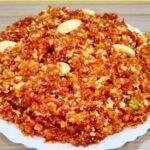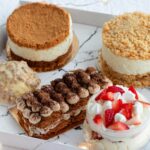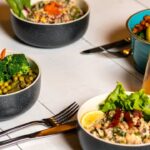The Best Fluffy Pancakes recipe you will fall in love with. Full of tips and tricks to help you make the best pancakes.
People who have attempted gluten-free dessert baking understand the problems involved in creating something similar to regular versions. Classic cheesecake treats deserve a perfect replacement that avoids compromises while staying true to the original without rebuilding the entire wheel process.
The gluten-free cheesecake provides an alternative dessert that exceeds expectations by replicating or surpassing original cheesecake quality.
According to this guide all bakers who create gluten-free cheesecakes for themselves as well as their family and friends who manage celiac disease or gluten sensitivity will discover a step-by-step method to prepare a reliable dessert with excellent taste.
Problem: Gluten-Free Desserts Often Miss the Blot
The progress of gluten-free dessert cuisine extends beyond shape and appearance but these alternatives lack the genuine taste and texture of traditional desserts. You understand the situation when you have eaten gluten-free pie crust that breaking like dry sand alongside dry gluten-free cakes that tasted chalky.
With cheesecake, this problem hits even harder. The change process requires more than traditional flour replacement since you must build a dessert that maintains the correct texture while meeting the requirements of structure and creaminess. A mistake during preparation can result in a wet crust as well as thick filling and top breakage.
The high price of gluten-free desserts from stores, along with their composition of extra which do not conform to a whole-foods approach creates significant drawbacks.
Agitate: Why Gluten-Free Baking Is Tricky—Especially for Cheesecake
The preparation of cheesecake presents significant challenges from the beginning. Traditional cheesecake requires precise care because of its specific requirements. The removal of gluten means stop a protein responsible for structural creation. The removal of gluten creates two essential problems: your base along with the filling, requires reworking to connect and bake evenly.
Here are the main challenges:
Graham crackers serve as standard crust material but they contain wheat that makes them unsuitable. The process of finding acceptable gluten-free substitutes for wheat-based crusts requires exhaustive testing to achieve the correct texture.
Gluten-free baking often depends on either thickening agents or additional starches because wheat ingredients provide different effects to fillings. The filling texture becomes altered when you use too many thickening agents.
People with celiac disease need to protect themselves from all gluten contact because even tiny particles of gluten can generate severe health reactions so they must exercise special care for their kitchen equipment along with ovens and storage vessels.
Many individuals might believe that creating gluten-free cheesecake should be avoided altogether after reading its various requirements. But it absolutely is.
Solution: A Tested, Flexible Gluten-Free Cheesecake That Just Works
You can prepare gluten-free cheesecakes that have both firm texture and creaminess by using suitablecomponents along with effective cooking methods while supporting a crust that maintainsits structure. No need to overthink it. The guide follows straightforward instructions while using everyday components along with essential basic steps.
This gluten-free dessert works at any level of baking experience because it focuses on maintaining equilibrium between texture and taste while omitting artificial attempts at mimicking traditional recipes.
Ingredients
Crust
- 1 ½ cups gluten-free graham cracker crumbs (or almond flour if preferred)
- ¼ cup sugar
- 6 tbsp unsalted butter, melted
- ½ tsp cinnamon (optional)
Filling
- 3 (8 oz) packages cream cheese, room temperature
- ¾ cup sugar
- 1 tsp vanilla extract
- 3 large eggs
- ⅔ cup sour cream
- 2 tbsp cornstarch (helps stabilize)
Optional Topping
- Fresh berries or fruit preserves
Instructions
1: Prepare the Crust
Preheat oven to 325°F (165°C).
A mixing bowl contains gluten-free graham cracker crumbs and sugar, which are then mixed with melted butter.
Press mixture into the bottom of a 9-inch springform pan.
The baking time lasts 10 minutes until you remove it and allow it to cool.
2: Make the Filling
The large bowl requires the cream cheese to be beaten into a smooth consistency
while avoiding anomalies.
Combine sugar with the mixture while mixing until the sugar dissolves.
Combine the eggs in the mixture one at a time while blending at a slow pace.
Stir together sour cream, vanilla extract, and cornflour into the mix.
Pour over cooled crust.
3: Bake the Cheesecake
Position the baking pan on a baking sheet while it bakes for 50–60 minutes for set edges and slight jiggling at the center.
Immediately turn off the oven and briefly open the door to allow cooling at room temperature for 1 hour.
Place the baked dessert into the refrigerator for a minimum of 4 hours or an extended overnight period.
4: Serve
Place fresh berries or keep them plain before serving. Serve the dish cold after slicing. Slice and serve chilled.
Real-Life Case Study: One Family’s Cheesecake Swap
The Chicago resident and mother, Angela Soto, started cooking gluten-free meals because her youngest child received a celiac disease diagnosis. Casemaking cheesecake proved to be her most difficult surrender, according to her. I devoted many months to developing an exact match between the authentic Graham crust and a smooth topping of cheesecake.
She finally developed a gluten-free graham-cracker filling with cornstarch that perfectly matched this recipe.
She added the gluten-free dessert to her family dinner without informing anyone about its special diet status so that nobody could detect its gluten-free nature. We now prepare this cheesecake regularly for celebrating birthdays alongside our festive events.
Why This Recipe Works
- The recipe contains authentic ingredients that cut out artificial stabilizers and strange gluten-free flour varieties.
- Tested ratios – Keeps texture firm but creamy
- This technique avoids water baths because the baking sheet method prevents cracking without extra processes.
- The baking recipe allows substitutions whereby you can utilize dairy-free versions of cream cheese and sour cream according to your needs.
Tips for Success
- Don’t overmix. Too much air causes cracks.
- Use room-temperature ingredients. Cold ingredients = lumpy batter.
- Let it rest. The time that the mixture spends in the refrigerator leads to improved texture.
- Avoid crumbly crusts. When substituting almond flour for crackers in the mixture, prepare an extra tablespoon of butter.
Frequently Asked Questions
Can I make it dairy-free too?
Yes. The meal requires dairy-free cream cheese combined with sour cream alternatives that Tofutti and Kite Hill brands work effectively. Brands like Kite Hill or Tofutti work well.
What gluten-free graham cracker brands work best?
Try Schär or Pamela’s brand. Gluten-free digestive biscuits and crushed almond cookies serve as other suitable options for the crust recipe.
How do I store gluten-free cheesecake?
The dessert can be refrigerated for five days or frozen with proper wrapping for two months.
Common Mistakes to Avoid
- Using low-fat cream cheese. It affects texture.
- The failure to cool the mixture in the oven prevents cracking. It helps prevent cracking.
- Mixing batter at high speed. The mixing technique produces uneven baked items because it forms spaces filled with air.
Serving Ideas
- Locate the blueberry or strawberry jam mixture on top
Dust with cocoa powder
- A dairy-free topping consists of the addition of whipped coconut cream.
- Slice over warm oatmeal for a breakfast twist
If you seek straightforward recipes similar to this one, you should refer to my guide for How to Make Simple Pancakes, which supplies a dependable, no-fuss breakfast suitable for brunch or dessert service.
Gluten-Free Cheesecake vs. Regular Cheesecake: How Do They Compare?
| Feature | Gluten-Free Cheesecake | Traditional Cheesecake |
|---|---|---|
| Crust | GF graham or almond | Graham crackers (wheat) |
| Filling Stability | Uses cornstarch | Often uses flour |
| Flavor Difference | Minimal if balanced | N/A |
| Cost | Slightly higher | Lower if using basic ingredients |
| Dietary Suitability | Celiac-safe | Contains gluten |
Special preparations of gluten-free ingredients by paying attention to measurement ratios enable consumers to identify no visible difference from the original version.
Final Thoughts: No Compromise Needed
Any home cook can prepare a gluten-free cheesecake that stays together without artificial additives and tastes rich enough to please everyone at dinner.
Your goal is to provide eating choices that benefit your body without sacrificing the celebration of taste quality. A single attempt to make this cheesecake will prepare you to experiment with different additions, including lemon zest and chocolate chips, and nut butter swirls.
The goal? You should create desserts that stand independently as primary event attractions rather than alternative choices.




